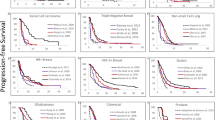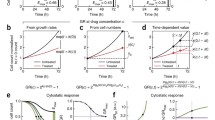Abstract
Cell cycle times are vital parameters in cancer research, and short cell cycle times are often related to poor survival of cancer patients. A method for experimental estimation of cell cycle times, or doubling times of cultured cancer cell populations, based on addition of paclitaxel (an inhibitor of cell division) has been proposed in literature. We use a mathematical model to investigate relationships between essential parameters of the cell division cycle following inhibition of cell division. The reduction in the number of cells engaged in DNA replication reaches a plateau as the concentration of paclitaxel is increased; this can be determined experimentally. From our model we have derived a plateau log reduction formula for proliferating cells and established that there are linear relationships between the plateau log reduction values and the reciprocal of doubling times (i.e. growth rates of the populations). We have therefore provided theoretical justification of an important experimental technique to determine cell doubling times. Furthermore, we have applied Monte Carlo experiments to justify the suggested linear relationships used to estimate doubling time from 5-day cell culture assays. We show that our results are applicable to cancer cell populations with cell loss present.






Similar content being viewed by others
References
Andrade, R., Crisol, L., Prado, R., Boyano, M. D., Arluzea, J., & Arechaga, J. (2010). Plasma membrane and nuclear envelope integrity during the blebbing stage of apoptosis: a time-lapse study. Biol. Cell, 102, 25–35.
Baguley, B. C., Marshall, E. S., & Finlay, G. J. (1999). Short-term cultures of clinical tumor material: potential contributions to oncology research. Oncol. Res., 11, 115–124.
Baguley, B. C., Marshall, E. S., Whittaker, J. R., Dotchin, M. C., Nixon, J., & McCrystal, M. R. (1995). Resistance mechanisms determining the in vitro sensitivity to paclitaxel of tumour cells cultured from patients with ovarian cancer. Eur. J. Cancer, 31, 230–237.
Baguley, B. C. (2011). The paradox of cancer cell apoptosis. Front. Biosci., 16, 1759–1767.
Barnes, J., Collins, B., Luft, C., & Allen, J. (2001). Expression of inducible Hsp70 enhances the proliferation of MCF-7 breast cancer cells and protects against the cytotoxic effects of hyperthermia. Cell Stress Chaperones, 6(4), 316–325.
Basse, B., Baguley, B. C., Marshall, E. S., Joseph, W. R., van-Brunt, B., Wake, G. C., & Wall, D. J. N. (2003). A mathematical model for analysis of the cell cycle in cell lines derived from human tumors. J. Math. Biol., 27, 95–106.
Basse, B., Baguley, B. C., Marshall, E. S., Joseph, W. R., van Brunt, B., Wake, G. C., & Wall, D. J. N. (2004a). A mathematical model for analysis of the cell cycle in cell lines derived from human tumors. Prog. Biophys. Mol. Biol., 85, 353–368.
Basse, B., Baguley, B. C., Marshall, E. S., Joseph, W. R., van Brunt, B., Wake, G. C., & Wall, D. J. N. (2004b). Modelling cell death in human tumour cell lines exposed to the anticancer drug paclitaxel. J. Math. Biol., 49(4), 329–357.
Begg, R. E., Wall, D. J. N., & Wake, G. C. (2008a). The steady-states of a multi-compartment, age-size distribution model of cell-growth. Eur. J. Appl. Math., 19(4), 1–24.
Begg, R., Wall, D. J. N., & Wake, G. C. (2008b). On the stability of steady size-distributions for a cell-growth process with dispersion. Differ. Integral Equ., 21(1–2), 1–24.
Begg, R., Wall, D. J. N., & Wake, G. C. (2010). On a multicompartment age-distribution model of cell growth. IMA J. Appl. Math., 75, 905–931.
Bell, G. I. (1968). Cell growth and division. iii. conditions for balanced exponential growth in a mathematical model. Biophys. J., 8, 431–444.
Bertuzzi, A., Faretta, M., Gandolfi, A., Sinisgalli, C., Starace, G., Valoti, G., & Ubezio, P. (2002). Kinetic heterogeneity of an experimental tumour revealed by BrdUrd incorporation and mathematical modelling. Bull. Math. Biol., 64, 355–384.
Chiorino, G., Metz, J. A. J., Tomasoni, D., & Ubezio, P. (2001). Desynchronisation rate in cell populations: mathematical modelling and experimental data. J. Theor. Biol., 208, 185–199.
Daukste, L., Basse, B., Baguley, B. C., & Wall, D. J. N. (2009). Using a stem cell and progeny model to illustrate the relationship between cell cycle times of in vivo human tumour cell tissue populations, in vitro primary cultures and the cell lines derived from them. J. Theor. Biol., 260, 563–571.
De Boer, R. J., Ganusov, V. V., Milutinovic, D., Hodgkin, P. D., & Perelson, A. S. (2006). Estimating lymphocyte division and death rates from CFSE data. Bull. Math. Biol., 68, 1011–1031.
Furneaux, C. E., Marshall, E. S., Yeoh, K., Monteith, S. J., Mews, P. J., Sansur, C. A., & Baguley, B. C. (2008). Cell cycle times of short-term cultures of brain cancers as predictors of survival. Br. J. Cancer, 99, 1678–1683.
Lee, H. Y., & Perelson, A. S. (2008). Modeling t cell proliferation and death in vitro based on labeling data: generalizations of the Smith–Martin cell cycle model. Bull. Math. Biol., 70, 21–44.
Prescott, D. M. (1987). Cell reproduction. Int. Rev. Cytol., 100, 93–128.
Rew, D. A., & Wilson, G. D. (2000). Cell production rates in human tissues and tumours and their significance. Part 1: an introduction to the techniques of measurement and their limitations. Eur. J. Surg. Oncol., 26, 227–238.
Rossa, B. (1995). Asynchronous exponential growth in a size structured cell population with quiescent compartment. In A. Arino, D. Axelrod, & M. Kimmel (Eds.), Carcinogenesis and cell & tumour growth (Vol. 2, pp. 183–200). Winnipeg: Wuerz
Steel, G. G. (1977). Growth kinetics of tumours. Oxford: Clarendon Press.
Taylor, I., Hodson, P., Green, M., & Sutherland, R. (1983). Effects of tamoxifen on cell cycle progression of synchronous MCF-7 human mammary carcinoma cells. Cancer Res., 43(9), 4007–4010.
Terry, N. H. A., & White, R. A. (2006). Flow cytometry after bromodeoxyuridine labeling to measure s and g 2+m phase durations plus doubling times in vitro and in vivo. Nat. Protoc., 1, 859–869.
Author information
Authors and Affiliations
Corresponding author
Appendices
Appendix A: Phase Solutions with no Division
We consider the solution when the system is not exhibiting BEG. Solving (1a)–(1c), when the transition rates between compartments are assumed to be positive constants and \(r_{G_{2}M\rightarrow G_{1}}\) is set to zero, gives us analytical formulas for the number of cells N p , p∈{G 1,S,G 2 M}, in each of the phases. We can subdivide the solution of the ODE system into two cases. Firstly, let \({r_{G_{1}\rightarrow S}}\neq r_{S\rightarrow G_{2}M}\), then the system of differential equations (1a)–(1c) can be solved analytically as follows:





Secondly, when \({r_{G_{1}\rightarrow S}}=r_{S\rightarrow G_{2}M}\), the analytical solution of the system (1a)–(1c) is:



But solution (30a)–(30c) will occur with probability of zero when running a Monte Carlo simulation such as in Sect. 3.3 so it is not considered further.
Appendix B: Proof of Theorem 2.1—Nonlinear Mapping Properties
As discussed in Sect. 2.1 for an established cell line, we have a relationship between proportions in each phase, the rate transitions between phases, the population doubling time and this can be reduced to an implicit relationship involving \(\mathbf{r}=\{ {r_{G_{1}\rightarrow S}},r_{S\rightarrow G_{2}M},r_{G_{2}M\rightarrow G_{1}}\}\), and \(\boldsymbol{\sigma}=\{ \varPi_{G_{1}},\varPi_{S}, \lambda\}\). So it can be shown that the system can be written
The existence of functional relationships between the variables will be determined by the implicit function theorem and this is conditional on certain characterisations of the Jacobian matrix of G, which is given by

Here




with F given by (7). We have partitioned J into the first three columns, and called this square matrix J σ , with the remaining three columns called J r , and then the implicit function theorem assures us that the Jacobian \(J_{\mathbf {r}}=\frac{d{\boldsymbol{\sigma}}}{{d\mathbf{r}}}\) exists locally provided the Jacobian J σ is non-singular, i.e.
This is true if ∂ λ F>0 as the proportional of cells in each phase are positive. To see that the condition on F is true for the domain under consideration here, we note for exponential growth that λ>0, and all the rates in (32a) are also positive, so that ∂ λ F>0. Hence the map σ=R(r) is locally unique and determined.
To invert this mapping, we must look into the singularity of J r and this can be determined from

so that provided detJ r ≠0 anywhere, a local map r(σ) will exist almost everywhere.
To prove this, we first look at (32b) and see this can be written

and in S′, F(λ)=1, with λ>0 so

A similar argument applies to the other two derivatives of F in (32a)–(32d). As in S′ all the transition probabilities and λ are positive, it follows that detJ r <0 and we have the result.
Appendix C: Approximate Solution of \(\mathcal{P}(\lambda)=0\)
To enable this, we look first at the dependence of F(λ)=1 on λ. So with the understanding of approximating the graph of F(λ), we consider a quadratic that crosses the x-axis at −β, −α and the y-axis at γ and that is positive for large x. We also assume that β<α. Then this quadratic is
Again with consideration of (7), we consider the roots of the equation y(x)=1, and these are given by
With the assumption \(\frac{4\alpha\beta}{(\beta+\alpha)^{2}}(\frac{1}{\gamma}-1)\ll 1\), the positive root is given by
When \(\frac{\alpha}{(\beta+\alpha)}\approx1\), which is true for |α| large. We then find an approximation to the positive root is
We observe that the root found to y(x)=1 if a linear polynomial is fitted through the x-axis at −β, and the y-axis at γ, i.e. y(0)=γ is (40) with no error term. So the degree of approximation is determined by how close \(\frac{\alpha}{(\beta+\alpha)}\approx1\). In conclusion, the linear approximation of λ in (7), when α,β are chosen from \(r_{S\rightarrow G_{2}M}\), \(r_{S\rightarrow G_{2}M}\) depending on which is larger, and the y-axis crossing is 1/2, is given by (26). This is because
and γ=2.
Rights and permissions
About this article
Cite this article
Daukste, L., Basse, B., Baguley, B.C. et al. Mathematical Determination of Cell Population Doubling Times for Multiple Cell Lines. Bull Math Biol 74, 2510–2534 (2012). https://doi.org/10.1007/s11538-012-9764-7
Received:
Accepted:
Published:
Issue Date:
DOI: https://doi.org/10.1007/s11538-012-9764-7





